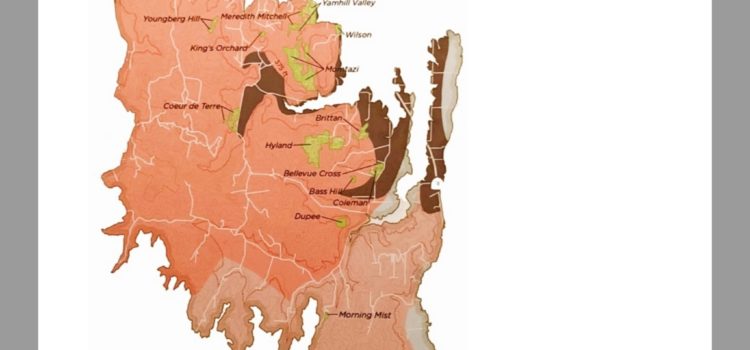
The Willamette Valley is a vast and varied appellation that includes ten nested AVAs | Chehalem Mountains, Dundee Hills, Eola-Amity Hills, Laurelwood District, Lower Long Tom, McMinnville, Ribbon Ridge, Tualatin Hills, Van Duzer Corridor, and Yamhill-Carlton. We are going to highlight each AVA and provide some hopefully fun and useful history along the way.
McMinnville AVA | An American Viticultural Area, or AVA, is a specific type of appellation of origin used on wine labels. An AVA is a delimited grape-growing region with specific geographic or climatic features that distinguish it from the surrounding regions and affect how grapes are grown. Established in 2005, the McMinnville AVA is an American Viticultural Area, contained within the Willamette Valley AVA and sits in the Coast Range foothills just west of the adorable little city of McMinnville. It extends approximately 20 miles south-southwest toward the mouth of the Van Duzer Corridor, Oregon’s lowest Coast Range pass to the Pacific Ocean. The soils of the McMinnville AVA are primarily uplifted marine sedimentary loams and silts, with alluvial overlays and a base of uplifting basalt and are uniquely shallow for winegrowing. Geologically, the most distinctive feature in this area is the Nestucca Formation, a 2,000-foot thick bedrock formation that extends west of the city of McMinnville to the slopes of the Coast Range. This formation is weathered sedimentary and volcanic soil sitting on top of marine bedrock, which affects the region’s ground water composition, forcing vines to struggle and produce complex fruit. Compared to surrounding AVA’s, McMinnville is on average cooler and drier, consisting of higher elevation vineyards and are resistant to frost. Vineyards situated on the more southerly facing sites take advantage of the cooling winds from the Van Duzer Corridor, a break in the Coast Range that allows cool Pacific Ocean air to flow through, thus dropping evening temperatures in the region, which helps grapes retain their acidity as they ripen. Pinot noirs from McMinnville typically exhibit a strong backbone of tannin with darker fruit flavors that are rounded out by spice, mineral and earth notes. White wines from this region are bright and fruit-forward. Other varietals that grow well here are Chardonnay and Pinot Blanc, just to name a few. Just over 45 minutes from Southwest Portland, this gem of an AVA offers over 750 planted acres, 16 vineyards, 4 wineries and 5 tasting rooms and counting. McMinnville is an overall experience you don’t want to miss.
Salud McMinnville!
McMinnville AVA |
